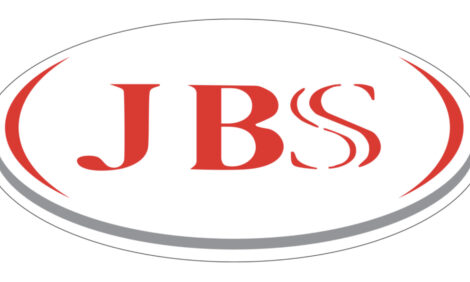



Glo Agrilamp LED Revolution Continues
UK - The headlines read: "1000 floor eggs a day reduced to 30-40 average"; "Reduced waste feed, a new way to look at FCR"; and with farmers reporting calmer flocks and improved animal welfare all over the world, what is it about the Glo Agrilamp that really makes the difference?In early 2008, after a six month rapid-development period carried out with a major egg producer in the UK, an extensive study of all the photometric data available from multiple key LED manufacturers, and a review of just about everything ever written on the effects of light on poultry species, Glo Agrilamp announced a brand new light bulb, to replace the 25watt incandescent light bulb, that was specifically built for poultry.
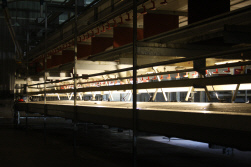
More than 99per cent of the original Glo Agrilamps are still in use, which probably equates to the longest real-time product test of any LED light bulbs to date.
Each of those original Glo Agrilamps will have saved the farmer £558.30 over the four years since installation, costing only £20.00 each. This incredible return on investment is resulting in some larger farms purchasing thousands of these revolutionary bulbs.
Today Glo Lighting, the company behind the Agrilamp, has taken the development of this light bulb, purpose-built for use in an agricultural environment, well beyond the limits of the present equivalent designed for domestic use, for example.
How?
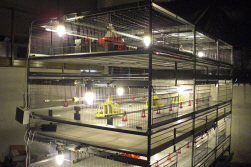
The initial development for a poultry light bulb was drawn from a short list written over many years by you the egg and broiler producers; the prerequisites were simple but absolute.
Energy-efficiency far superior to a Compact Fluorescent (CFL); dimmable, just like an incandescent; reliable; tough; waterproof; and the last two requests came from the food industry, the supermarkets and their customers: no methyl mercury and no glass.
When you look at the very first Glo Agrilamp light bulb it visually resembled just about any other LED light bulb on the market; the differences were not obvious, as dimming and energy efficiency were the primary objectives; with all this going on inside the bulb, the differences could not be clearly seen.
Today the current Glo Agrilamp range is a whole new tool for the poultry industry and the devil is clearly in the detail.
So what's changed?
The lessons we learned included not having visible screw fittings holding the bulbs together: they simply rust and break in the harshest of environments; the chemicals used in our industry are very aggressive and need to be seriously considered.
Glo Agrilamp is now a blend of protected aluminium alloys and chemical-resistant plastics; we no longer use external screws.
No openings that would allow any humidity to enter the lamps via a process of condensation, a process that takes place every time the lamp heats up or cools down therefore at least twice a day.
Glo Agrilamp is now completely sealed from the outside world and the AG Adaptor allows for the adaptation of a standard armature and glass-jar light fittings to be upgraded to LED.
Avoid mixing metals - electrolysis and those nasty chemicals can make short work of any steel fixings against aluminium heat sinks. Glo Agrilamp only uses protected aluminium alloys on the outside of its light bulbs.
Never glue lenses into LED light bulbs, they simply fall out with the right combinations of heat, humidity, ammonia and chemicals.
Glo Agrilamp has a special lens fitting; in reality we can never be sure what chemicals will come into use to defend us against disease and bacteria as the world changes. So we had to make the Glo Agrilamp future-proof: even if the bonding we use today eventually fails due to some unseen new chemical mixture, the lenses will never come out.
Glass in the food chain has always caused concerned for Supermarkets.
All Glo Agrilamps that can come into contact with employees or machinery during production are now glass-free.
Mercury or Methyl Mercury. There is much evidence about Methyl Mercury and its effects on the food chain and direct contact with livestock or humans. Not to mention its ability to pass directly to an unborn child. Methyl Mercury is found in all CFLs, they just don't work without it. The government advises you on the correct action for a single broken lamp in the home; who knows what you should do for a dozen in a barn over a year.
DEFRA 2007 Products and appliances: energy saving light bulbs
"How should I deal with a broken CFL?
Although the accidental breakage of a lamp is most unlikely to cause any health problems, it's good practice to minimise any unnecessary exposure to mercury, as well as risk of cuts from glass fragments.
Vacate the room and ventilate it for at least 15 minutes. Do not use a vacuum cleaner, but clean up using rubber gloves and aim to avoid creating and inhaling airborne dust.
Sweep up all particles and glass fragments and place in a plastic bag. Wipe the area with a damp cloth, then add that to the bag and seal it.
Mercury is hazardous and the bag should not be disposed of in the bin.
All local councils have an obligation to make arrangements for the disposal of household hazardous waste at a civic amenity site or household waste recycling centre.
The National Household Hazardous Waste Forum runs a website with details of these centres for chemicals, but which also applies to other hazardous wastes (www.chem-away.org.uk/). Alternatively contact your local council direct."
None of which is possible in a poultry building.
Glo does not use Mercury
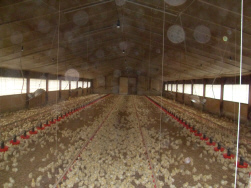
CFLs have sadly been let down by the major manufacturers in our industry, they should never be fitted into glass protective housings as they need ventilation to keep cool; the circuits simply get too hot and die and the life of the product is dramatically reduced. These bulbs were undoubtedly a quick fix to the energy issues fifteen years ago, but they were the VHS Video to today's Blue Ray disk. They have had their day and life goes on.
LED allows us to modify the light output in a light bulb such that it is best suited to poultry species, and the wavelengths required are well documented, they are not the same as for humans; and as the LED light bulb for domestic use gets ever closer to the perfect human bulb it gets ever further away from the requirements of poultry. Dimming is now 0-100per cent - we use only safe 230v solutions that do not have the same risks of fire as with rope lighting and some tube lights running on 12v and 24v Dc power supplies.
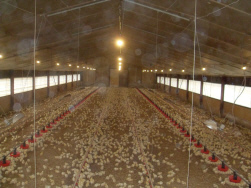
Research continues into the effects of lighting on poultry and now we regularly receive data from around the world that helps us further our understanding of how best to light the poultry production environment. As legislation enforces new light levels we have developed products like the 30w Broiler lamp to provide an even and powerful tool for the broiler producer, reducing energy levels from around 6.7kw hours at 13 lux to just 450watt hours in a 90meter x 24meter building at 20 lux; it's a very real and huge energy saving.
Research in Switzerland is proving that red light is not good for poultry and that green light actually has a negative effect on broilers and layers; we are now testing how to best use this scientific evidence. But we already knew this thanks to our early studies.
In just a few weeks the largest single energy and efficiency test in the world, funded by Glo Lighting and the two largest power companies in the USA, will begin at the University of Georgia Poultry Extension Unit under the watchful eyes of Michael Czarick and Brian Fairchild. We look forward to the energy results and further advancing the technology.
The NEW Glo Agrilamp Tulip (side emitting light bulb) now puts more than twice the light of a rope or tube light into Aviary, Colony and Cage Systems for both layers and broilers while have a calming effect on flocks and clearly reducing feather loss. Not to mention the huge reductions in floor eggs.
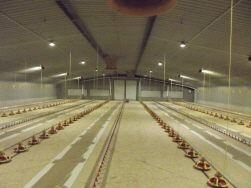
Glo Lighting now provides a wide range of Agrilamp products that replace the 25w, the 40w and 60w incandescent light bulbs; the high-power halogen yard lights are now a thing of the past as our farm light uses only 80watts and puts out as much light as a 750w halogen.
"We are a long way from the first Glo Agrilamp and still at least four years ahead of the competition; that's because we listened to you the farmer and we continue to. We are keeping our promise and will continue to build light bulbs specifically for Poultry and we will keep improving the research and development to help you improve your profits.
"And because you the farmer has asked us to, we now build lighting for pigs, cattle, and fish; we're now also just beginning the development of plant-specific lighting, but that's a whole new story.
"We look forward to being able to continue making a difference and thank you for your input and support.








